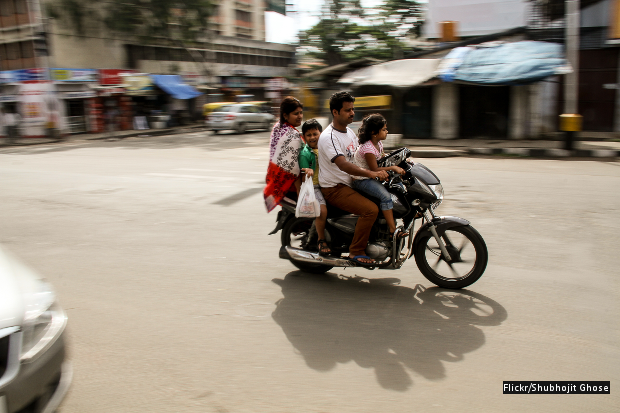Not 264 Million, Middle Class Is 24 Million: Report
- India accounts for 3% of the global middle class with 23.6 million people.
- It has the lowest threshold for a person to be considered middle class with annual wealth of $13,662 (Rs 737,748 or Rs 61,480 per month).
- With 23.6 million people, the Indian middle class holds almost a quarter of the country’s wealth at $780 billion (Rs 5,070,000 crore).
These are some of the findings of Credit Suisse, a global financial services firm based in Zurich, from its Global Wealth Report 2015.
The report estimated that 664 million adults belonged to the global middle class in 2015, or 14% of the adult population. India has 23.6 million adults who qualified as middle class in 2015.
There is no clear definition of middle class in India, but the latest definition dramatically lowers the number of Indians considered to fall in that category.
A McKinsey Global Institute study in 2005 using National Council of Applied Economic Research (NCAER) data said 50 million people were middle class, using the definition of real annual household disposable income between Rs 200,000 and Rs 1 million.
At the other end of the spectrum, a study by the World Bank in 2005 estimated the middle class at 264 million, using the median poverty line in 70 countries at the lower extreme ($2 per day) and the United States poverty line ($13 per day) as an upper extreme.
Another method, used by television channel CNN-IBN in its middle class survey in 2007, utilised consumption-based household criteria: Car or scooter, colour television, or telephone. It estimated that the middle class was approximately 20% of the population or slightly over 200 million people.
Middle class measured by wealth not income
The Credit Suisse report has estimated the middle class on the basis of their wealth rather than their income.
“An income-based definition of the middle class misses elements of freedom and security. It suggests, for example, that a spell of unemployment can cause middle class status to evaporate. A wealth-based definition, on the other hand, conforms better to the widespread view that middle class membership is resilient to temporary setbacks,” the report said.
In India, the estimated value of wealth to be considered middle class must be more than or equal to $13,662 (Rs 737,748).
The growth of wealth has been the fastest in India (second only to China) over 15 years (2000-2015), even correcting for population growth.
Yet, more than 90% of the adult population falls in the bottom of the wealth pyramid (less than $10,000), indicating the uneven distribution of wealth in India.
At the top of the global ladder, 2% of high net-worth individuals (HNWIs) reside in India, Africa or Latin America.
With 108 million people, China has the highest middle-class population among BRICS nations and globally, followed by India’s 23.6 million people and Brazil’s 11.2 million.
China also tops the share of the global middle-class population with 16.4%, followed by India with 3%.
The number of middle-class adults in China increased 38 million between 2000 and 2015, and their wealth rose by $5.6 trillion, overtaking the US, which, thus far, had the highest number of middle-class adults.
Over 15 years, 6.7 million adults join middle class
India added 6.7 million adults to the middle class over these 15 years, and middle-class wealth rose by $1.2 trillion.
“One of the reasons for this different experience is partly due to faster overall wealth growth in China, and partly because the populous mid-portion of the Chinese wealth distribution is moving into the global middle class, whereas it is still far from doing so in India,” the report said.
As many as 11 other countries have more than 10 million middle-class citizens: Japan, 62 million; France, Italy, Germany, India, Spain and United Kingdom, between 20 million and 30 million each; and Australia, Brazil, Canada and Korea, with 10 million to 17 million each.
The middle class in India has a 22.6% share ($780 billion or Rs 5,070,000 crore) of the country’s wealth, while sections above the middle class (higher middle-class) share about 64% of the wealth.
The Chinese middle class has an estimated wealth of about $16,845 billion, which is a 32% share of that country’s wealth and 2.9% of the world’s wealth.
The Brazilian middle class ranks third among the BRICS nations, with a total wealth of $754 billion; 31% of the country’s wealth and 0.3% of global wealth.
Share of middle-class wealth falls globally—except in China
Wealth per middle-class adult in India has more than doubled from $2,040 (Rs 97,104) in 2000 to $5,100 (Rs 205,020) in 2007.
After falling by about 26% during the financial crisis of 2008, it bounced to $5,300 (Rs 241,150) in 2010. It continued to fall due to adverse exchange rates and was estimated at $4,352 (Rs 282,880) in 2015.
Wealth is dominated by real assets, which account for about 86% of estimated household assets.
The share of middle-class wealth has fallen globally since 2008, except in China, over the period 2000 to 2015.
Note: Conversion rates used; 2000 = Rs 47.6/$; 2007 = Rs 40.2/$; 2010 = Rs 45.2/$ and 2015 = Rs 65/$
(Salve is an analyst with IndiaSpend.)
__________________________________________________________________
“Liked this story? Indiaspend.org is a non-profit, and we depend on readers like you to drive our public-interest journalism efforts. Donate Rs 500; Rs 1,000, Rs 2,000.”



